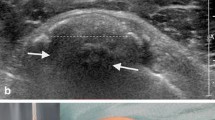Abstract
Calcific tendinitis of the shoulder is a dynamic process. Osteopontin is present in cells surrounding tendon calcifications. Resorption is probably mediated by cathepsin K-containing multinucleated giant cells. Rotator cuff tears are associated with an inflammatory response based on the presence of interleukin-1 and a proliferative synovitis. Metalloproteinases are found in the synovial fluids of patients with rotator cuff tears. Some patients with large rotator cuff tears progress to a severe destructive arthropathy characterized by large joint effusions, which are noninflammatory but contain basic calcium phosphate crystals. These crystals stimulate metalloproteinase production in vitro and also suppress metalloproteinase inhibitor production. Mutations in the ank gene result in decreased extracellular inorganic pyrophosphate in murine progressive ankylosis, and increased extracellular inorganic pyrophosphate in some cases of familial chondrocalcinosis.
Similar content being viewed by others
References and Recommended Reading
Sano H, Ishii H, Trudel G, Uhthoff HK: Histological evidence of degeneration at the insertion of 3 rotator cuff tendons: a comparative study with human cadaveric shoulders. J Shoulder Elbow Surg 1999, 8:574–579.
McCarty DJ, Lehr JR, Halverson PB: Crystal populations in human synovial fluid: identification of apatite, octacalcium phosphate, and tricalcium phosphate. Arthritis Rheum 1983, 26:1220–1224.
Uhthoff HK, Sarkar K, Maynard JA: Calcifying tendinitis: a new concept of its pathogenesis. Clin Orthop 1976, 118:164–168.
Takeuchi E, Sugamoto K, Nakase T, et al.: Localization and expression of osteopontin in the rotator cuff tendons in patients with calcifying tendinitis. Virchows Archiv 2001, 438:612–617.
Nakase T, Takeuchi E, Sugamoto K, et al.: Involvement of multinucleated giant cells synthesizing cathepsin K in calcified tendinitis of the rotator cuff tendons. Rheumotology 2000, 39:1074–1077.
Halverson PB, Carrera GF, McCarty DJ: Milwaukee shoulder syndrome: fifteen additional cases and a description of contributing factors. Arch Intern Med 1990, 150:677–682.
Jensen KL, Williams GR Jr, Russell IJ, Rockwood CA Jr: Rotator cuff tear arthropathy. J Bone Joint Surg 1999, 81:1312–1324.
Yamaguchi K, Tetro AM, Blam O, et al.: Natural history of asymptomatic rotator cuff tears: a longitudinal analysis of asymptomatic tears detected sonographically. J Shoulder Elbow Surg 2001, 10:299–303.
Gotoh M, Hamada K, Yamakawa H, et al.: Interleukin-1- induced subacromial synovitis and pain in rotator cuff diseases. Rheumatology 2001, 40:995–1001. Rotator cuff tears are associated with production of IL-1 and synovitis, indicating an inflammatory process.
Gotoh M, Hamada K, Yamakawa H, et al.: Perforation of the rotator cuff increases interleukin 1 beta production in the synovium of glenohumeral joint in rotator cuff diseases. J Rheumatol 2000, 27:2886–2892.
Yanagisawa K, Hamada K, Gotoh M, et al.: Vascular endothelial growth factor (VEGF) expression in the subacromial bursa increased in patients with impingement syndrome. J Orthop Res 2001, 19:448–455.
Yoshihara Y, Hamada K, Nakajima T, et al.: Biochemical markers in the synovial fluid of glenohumeral joints from patients with rotator cuff tear. J Orthop Res 2001, 19:573–579. Matrix metalloproteinases have been found in synovial fluids of patients with rotator cuff tears. This helps to explain the progression of rotator cuff tears seen in some patients and may also explain the development of severe destructive arthropathies such as Milwaukee shoulder syndrome.
Dieppe PA, Doherty M, Macfarlane DG, et al.: Apatite associated destructive arthritis. Br J Rheumatol 1984, 23:84–91.
Neer CS II, Craig EV, Fukuda H: Cuff tear arthropathy. J Bone Joint Surg 1983, 65:1232–1244.
Bokor DJ, Hawkins RJ, Huckell GH, et al.: Results of nonoperative management of full-thickness tears of the rotator cuff. Clin Orthop 1993, 294:103–110.
Hamada K, Fukuda H, Mikasa M, Kobayashi Y: Roentgenographic findings in massive rotator cuff tears: a long-term observation. Clin Orthop 1990, 254:92–96.
Pons-Estel BA, Gimenez C, Sacnun M, et al.: Familial osteoarthritis and Milwaukee shoulder associated with calcium pyrophosphate and apatite crystal deposition. J Rheumatol 2000, 27:471–480.
Hamilton JA, McCarthy G, Whitty G: Inflammatory microcrystals induce murine macrophage survival and DNA synthesis. Arthritis Res 2001, 3:242–246.
Reuben PM, Wenger L, Cruz M, Cheung HS: Induction of matrix metalloproteinase-8 in human fibroblasts by basic calcium phosphate and calcium pyrophosphate dihydrate crystals: effect of phosphocitrate. Conn Tissue Res 2001, 42:1–12.
Bai G, Howell DS, Howard GA, et al.: Basic calcium phosphate crystals upregulate metalloproteinases but down-regulate tissue inhibitor of metalloproteinase-1 and -2 in human fibroblasts. Osteoarthritis Cartilage 2001, 9:416–422.
Reuben PM, Brogley MA, Sun Y, Cheung HS: Molecular mechanism of the induction of metalloproteinases 1 and 3 in human fibroblasts by basic calcium phosphate crystals: role of calcium-dependent protein kinase C. J Biol Chem 2002, 277:115190–115198. This is an interesting study, because BCP crystals induced metalloproteinases and also suppressed the inhibitors of metalloproteinases. Tissue inhibitor of metalloproteinase, which analyzed synovial fluids, was not reduced.
Sun Y, Wenger L, Brinckerhoff CE, et al.: Basic calcium phosphate crystals induce matrix metalloproteinase-1 through the ras/mitogen-activated protein kinase/c-Fos/AP-1/metalloproteinase 1 pathway: involvement of transcription factor binding sites AP-1 and PEA-3. J Biol Chem 2002, 277:1544–1552.
D’Angelo M, Billings PC, Pacifici M, et al.: Authentic matrix vesicles contain active metalloproteases (MMP): a role for matrix vesicle-associated MMP-13 in activation of transforming growth factor-b. J Biol Chem 2001, 276:11347–11353.
Rutsch F, Vaingankar S, Johnson K, et al.: PC-1 nucleoside triphosphate pyrophosphohydrolase deficiency in idiopathic infantile arterial calcification. Am J Pathol 2001, 158:543–554.
Terkeltaub R: What does cartilage calcification tell us about osteoarthritis? J Rheumatol 2002, 29:412–415.
Ho AM, Johnson MD, Kingsley DM: Role of the mouse ank gene in control of tissue calcification and arthritis. Science 2000, 289:265–270.
Pendleton A, Johnson MD, Hughes A, et al.: Mutations in ANKH cause chondrocalcinosis. Am J Hum Gen 2002, 71:933–940. This study provides important information in the understanding of familial chondrocalcinosis. Increased activity of mutated ANKH protein results in elevated levels of extracellular PPi.
Author information
Authors and Affiliations
Rights and permissions
About this article
Cite this article
Halverson, P.B. Crystal deposition disease of the shoulder (including calcific tendonitis and milwaukee shoulder syndrome). Curr Rheumatol Rep 5, 244–247 (2003). https://doi.org/10.1007/s11926-003-0074-9
Issue Date:
DOI: https://doi.org/10.1007/s11926-003-0074-9




